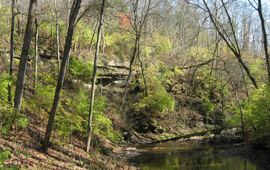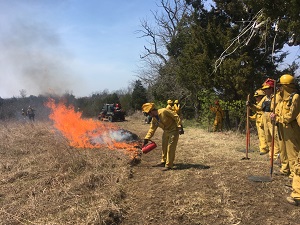KNP protects and manages the diverse system of nature preserves and natural areas across the Commonwealth, from Mississippi River wetlands to Pine Mountain on the Virginia border. Activities center around several key focus areas: natural community restoration and management; rare species protection and enhancement; research and education; hiking trail maintenance; and the Registered Natural Areas Program.
Natural Community Restoration
Kentucky is a biologically diverse state. Geology, soils, topography, assemblages of native plants  and animals, along with other factors, combine in unique ways that make up natural communities. Forests, wetlands, glades, grasslands and other habitat types can be classified into categories that are known as natural or ecological communities. High quality natural communities are very rare due to widespread human disturbance but remnants do exist. Commission ecologists use the Natural Areas Inventory to survey the state for the remaining high quality natural communities. Areas containing these communities are glimpses into what Kentucky’s landscape looked like before it was settled and developed. When the commission does locate a significant natural area, efforts are made to protect it, usually as a dedicated state nature preserve.
and animals, along with other factors, combine in unique ways that make up natural communities. Forests, wetlands, glades, grasslands and other habitat types can be classified into categories that are known as natural or ecological communities. High quality natural communities are very rare due to widespread human disturbance but remnants do exist. Commission ecologists use the Natural Areas Inventory to survey the state for the remaining high quality natural communities. Areas containing these communities are glimpses into what Kentucky’s landscape looked like before it was settled and developed. When the commission does locate a significant natural area, efforts are made to protect it, usually as a dedicated state nature preserve.
Once a natural area is conserved by a KNP program, the natural areas management work begins. It is rare to conserve a new area in pristine condition. It is the manager’s job to restore the site to the condition it was in prior to any human influences that have adversely affected a site's natural processes and habitat. Invasive plants, fire suppression and poor land-use practices are some of the issues that must be addressed when planning for site restoration.
The restoration of natural communities can take years, and even decades, to achieve. Despite the difficult and sometimes tedious work, restoring natural areas is very rewarding. Preserving remnants of Kentucky’s original landscape and maintaining havens where our natural communities and native species can survive is a crucial part of having healthy ecosystems and preserving our rich natural heritage.
Invasive Species Management
Most natural areas have some level of invasive plant infestation. Next to habitat destruction, invasive plants are the greatest threat to natural communities. Invasive species displace native plants thereby altering the structure and composition of natural areas. This change can be so severe that many native plants and animals can no longer survive. Invasive plants on state nature preserves are controlled by the most effective means known for each species, often a combination of mechanical control (mowing and trimming) and the judicious use of herbicides. Visit iMap invasives guides for information on identification and management of some of the most commonly observed invasive plants in Kentucky. For more information about invasive plants and to see what others are doing about this growing threat to our native biodiversity, visit the Southeast Exotic Pest Plant Council website.
Fire suppression enables trees and shrubs to grow into the more open glade and barrens communities, shading out sun loving species. After careful planning, nature preserve staff use prescribed fire to set back the overtaking trees. Controlled fire also benefits many native fire-dependent species.
 Fire Management
Fire Management
Effective natural areas management requires use of a diverse array of techniques. One technique used on KNP natural areas for decades is prescribed fire. Prescribed fire helps to restore or improve the conditions of fire-dependent natural communities within selected state nature preserves. These natural communities often provide habitat for rare, threatened and endangered species.
One factor in the rarity of certain species is the history of fire suppression in the United States since European settlement. A number of rare plants require some sort of disturbance regime (e.g. fire, grazing, flooding) to ensure strong and healthy populations. The reintroduction of fire into a disturbance-dependent community can help control the spread of shade-casting woody plants and invasive exotic species that compete with native plants for sunlight and resources.
Safety is of paramount importance on prescribed burns. Each burn is conducted by KNP staff trained to Kentucky Prescribed Fire Council standards, often with partnering agencies like the Kentucky Divsion of Forestry or Kentucky Department for Fish and Wildlife Resources. KNP areas are always burned according to a prescription developed by the KNP Fire Management Officer. The prescription states the ecological objectives for the burn and includes a set of parameters for air temperature, wind speed and direction, fuel moisture and relative humidity. If on-site conditions do not meet these parameters, the burn will be rescheduled.
The area to be burned is called a unit. Prior to the burn date, a unit is carefully prepared by clearing flammable material from its perimeter, creating a firebreak. Specialized equipment such as drip torches, a skid unit fire engine, flame-resistant Nomex coveralls and other safety gear is used by the crew on the fireline. Fires set along the firebreak are closely monitored by the burn crew. Staffing and weather conditions dictate the number of burns that can be accomplished during the burn season. For maximum impact, the spring prescribed fire season is timed to coincide with leaf break of targeted trees and shrubs. Fall burn season is scheduled following hard frosts that help to dry out the vegetation and improve its flammability.
Recent studies have shown that populations of insects dependent on remnant grassland habitat continue to occur in units burned multiple times. Research conducted at those sites suggests that the populations respond well to a prescribed fire regimen with three-year intervals between burns. Populations of Short’s goldenrod (Solidago shortii), a federally endangered plant, at Blue Licks State Park Nature Preserve have increased due to more sunlight and open space resulting from repeated burning. At Crooked Creek Barrens State Nature Preserve, numbers of the state endangered slender blazing star (Liatris cylindracea) have risen as well.
Rare Species Restoration
 The Office of Kentucky Nature Preserves is charged with monitoring and preserving rare species and natural communities throughout the Commonwealth. KNP biologists systematically search the state to find new species and more populations of known rarities. The state nature preserve system protects only a fraction of the listed species of plants, insects, mammals, fishes, mussels, snails, arachnids, crustaceans, amphibians, reptiles, birds and natural communities in the Commonwealth. KNP's Kentucky Biological Assessment Tool database currently monitors 763 state and federal listed endangered, threatened and special concern plant and animal species. High-quality examples of 59 natural communities are also monitored. KNP works with other organizations and private individuals to ensure the protection of additional populations of rare species and natural communities.
The Office of Kentucky Nature Preserves is charged with monitoring and preserving rare species and natural communities throughout the Commonwealth. KNP biologists systematically search the state to find new species and more populations of known rarities. The state nature preserve system protects only a fraction of the listed species of plants, insects, mammals, fishes, mussels, snails, arachnids, crustaceans, amphibians, reptiles, birds and natural communities in the Commonwealth. KNP's Kentucky Biological Assessment Tool database currently monitors 763 state and federal listed endangered, threatened and special concern plant and animal species. High-quality examples of 59 natural communities are also monitored. KNP works with other organizations and private individuals to ensure the protection of additional populations of rare species and natural communities.
The leading reasons species become rare are habitat destruction and competition from the influx of exotic invasive species. Some rare species have an extremely limited distribution, and habitat loss within that range can lead to extinction. The state nature preserves are often one of the last safe havens for declining species. In Kentucky the federally-listed globe bladderpod (Lesquerella globosa) survives only in the Kentucky and Licking River drainages within the Bluegrass region. Rockcress Hills State Nature Preserve (SNP) supports the only known population of Lesquerella globosa on public land. KNP's rare plant recovery botanists are working to restore this plant to other nearby natural areas in an effort to stabilize the species.
The blackside dace (Chrosomus cumberlandensis) is a federally threatened fish that occurs in high-quality streams of the upper Cumberland River. The temperature and silt load of these streams are regulated by the distinct ecological community surrounding them, characterized by the eastern hemlock (Tsuga canadensis) and great rhododendron (Rhododendron maximum). The dace tolerates only a narrow set of environmental parameters; logging and mining activities have compromised the quality of many streams in its range. This community is now being threatened by the hemlock wooly adelgid (Adelges tsugae), an insect introduced from Asia, which kills hemlock trees by feeding on sap drawn from the needles. Elsewhere in Appalachia this insect has caused mortality rates of over 90 percent of hemlock trees. At Bad Branch State Nature Preserve and Blanton Forest State Nature Preserve, continuing efforts to slow the spread of the adelgid are showing signs of success. To date, tens of thousands of hemlock trees of different size- and age-classes have been treated by soil injection of insecticide to protect the streams that support the dace. Treatment assistance has come from KNP staff, volunteers, the Kentucky Division of Forestry, and other partners.
Terrapin Creek SNP in Graves County protects several species of fish found nowhere else in the state including a species of lamprey (fish) new to science that is related to the least brook lamprey (Lampetra aepyptera). This lamprey is found nowhere outside of Terrapin Creek and the unique spring runs located there. By protecting Terrapin Creek and the surrounding spring runs, the commission hopes to preserve this unique species.
Much of KNP's habitat management centers on enhancing known populations of rare species and restoring the natural communities that support them. Management efforts have brought some very rewarding success stories. The federally endangered Short’s goldenrod (Solidago shortii) protected at Blue Licks State Park Nature Preserve in Robertson County is one example. There has been a significant increase in flowering stems that resulted from the sunnier, more open conditions provided by the prescribed fires and cedar removal implemented at Blue Licks SPNP.
Cumberland Plateau Shortleaf Pine Barrens
This rare community is typically found on broad, flat, or gently sloping sandstone ridges with well drained shallow soils throughout the plateau. The canopy is open to semi-open and encourages an understory dominated by grasses and mixed-forbs that offer habitat for a host of insects, birds, mammals, and rare plants. This is a fire-maintained community restricted to the Cumberland Plateau in Kentucky. Due to lack of fire, improper logging techniques, and recent pine beetle infestations, this community type has been greatly reduced and altered, with few high-quality examples remaining in Kentucky. The Office of Nature Preserves tracks or monitors twenty-one conservative or rare plant species that occur in this community type, and has made restoration of these communities a high priority for the next few years. Current efforts are focused on increasing prescribed fire within the plateau, cultivation of rare plants associated with these communities for reintroduction, and increasing public awareness.